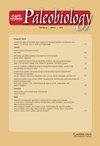Examining competition during the agnathan/gnathostome transition using distance-based morphometrics
IF 2.7
2区 地球科学
Q2 BIODIVERSITY CONSERVATION
引用次数: 1
Abstract
Abstract. The rise of jawed vertebrates (gnathostomes) and extinction of nearly all jawless vertebrates (agnathans) is one of the most important transitions in vertebrate evolution, but the causes are poorly understood. Competition between agnathans and gnathostomes during the Devonian period is the most commonly hypothesized cause; however, no formal attempts to test this hypothesis have been made. Generally, competition between species increases as morphological similarity increases; therefore, this study uses the largest to date morphometric comparison of Silurian and Devonian agnathan and gnathostome groups to determine which groups were most and least likely to have competed. Five agnathan groups (Anaspida, Heterostraci, Osteostraci, Thelodonti, and Furcacaudiformes) were compared with five gnathostome groups (Acanthodii, Actinopterygii, Chondrichthyes, Placodermi, and Sarcopterygii) including taxa from most major orders. Morphological dissimilarity was measured by Gower's dissimilarity coefficient, and the differences between agnathan and gnathostome body forms across early vertebrate morphospace were compared using principal coordinate analysis. Our results indicate competition between some agnathans and gnathostomes is plausible, but not all agnathan groups were similar to gnathostomes. Furcacaudiformes (fork-tailed thelodonts) are distinct from other early vertebrate groups and the least likely to have competed with other groups.使用基于距离的形态计量学检查agnathan/gnathostome转变过程中的竞争
摘要有颌脊椎动物的兴起和几乎所有无颌脊椎动物的灭绝是脊椎动物进化中最重要的转变之一,但其原因尚不清楚。泥盆纪时期巨齿目动物和颌口动物之间的竞争是最常见的假设原因;然而,还没有正式的尝试来检验这一假设。一般来说,物种之间的竞争随着形态相似性的增加而增加;因此,这项研究使用了迄今为止最大的志留纪和泥盆纪agnathan和gnathostome群体的形态测量学比较,以确定哪些群体最有可能竞争,哪些最不可能竞争。比较了5个agnathan类群(Anaspida、Heterostraci、Osteostraci、theelodonti和Furcacaudiformes)与5个颌目类群(Acanthodii、Actinopterygii、Chondrichthyes、Placodermi和Sarcopterygii)的主要目分类。采用Gower’s不相似系数测量形态差异,采用主坐标分析比较早期脊椎动物形态空间中agnathan和gnathithome体型的差异。我们的研究结果表明,一些agnathans和颌口动物之间的竞争是合理的,但并不是所有的agnathans都与颌口动物相似。叉尾动物与其他早期脊椎动物群体截然不同,最不可能与其他群体竞争。
本文章由计算机程序翻译,如有差异,请以英文原文为准。
求助全文
约1分钟内获得全文
求助全文
来源期刊

Paleobiology
地学-古生物学
CiteScore
5.30
自引率
3.70%
发文量
38
审稿时长
>12 weeks
期刊介绍:
Paleobiology publishes original contributions of any length (but normally 10-50 manuscript pages) dealing with any aspect of biological paleontology. Emphasis is placed on biological or paleobiological processes and patterns, including macroevolution, extinction, diversification, speciation, functional morphology, bio-geography, phylogeny, paleoecology, molecular paleontology, taphonomy, natural selection and patterns of variation, abundance, and distribution in space and time, among others. Taxonomic papers are welcome if they have significant and broad applications. Papers concerning research on recent organisms and systems are appropriate if they are of particular interest to paleontologists. Papers should typically interest readers from more than one specialty. Proposals for symposium volumes should be discussed in advance with the editors.
 求助内容:
求助内容: 应助结果提醒方式:
应助结果提醒方式:


